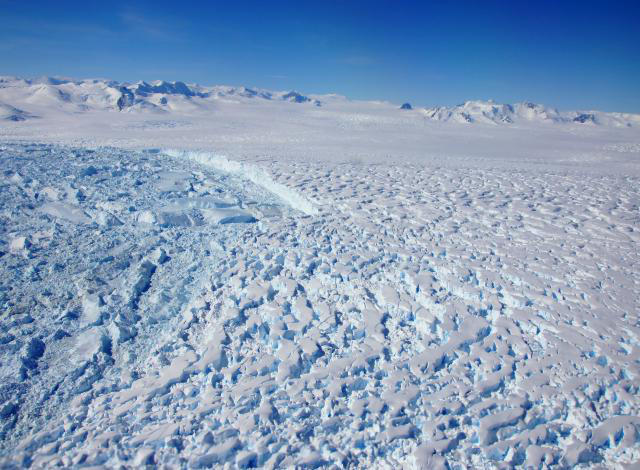How ice-shelf loss leads to faster sea-level rise
Over the past 20 years, many ice shelves in Antarctica have shrunk and some have disappeared entirely. This has resulted in a significant acceleration of many Antarctic glaciers, contributing to rising sea levels.
Dr. Johannes Fürst from the Institute of Geography at FAU has used a complex model to show for the first time at what point the “buttressing” role of ice shelves is impaired due to their decline. The results of Dr. Fürst’s research, carried out in collaboration with Antarctic experts from Laboratoire de Glaciologie et Géophysique de l’Environnement (LGGE) in Grenoble, France, have been published in the journal Nature Climate Change*.
Antarctica is surrounded by huge ice shelves. The largest of these, the Ross Ice Shelf, has an area comparable to the size of Spain. These ice shelves are several hundred metres thick and float on the surface of the sea, towering above the water. They are firmly linked to glaciers and ice streams on mainland Antarctica. These ice shelves are naturally fed by upstream inflow from tributary glaciers which push the floating ice seawards. Away from the mainland, at the seaward fronts of these ice shelves, ice breaks off as vast icebergs which drift away. This loss of ice is usually compensated for by land ice flowing in to replace it. This natural balance prevailed for thousands of years.
Ice-shelf retreat since 1995
However, over the past 20 years, researchers observed the progressive retreat and break-up of ice shelves on the Antarctic Peninsula. In 1995, Larsen A Ice Shelf collapsed completely removing the ice-cover from an area the size of Berlin. Seven years later, the much larger Larsen B Ice Shelf broke apart. This disintegration had hardly any immediate effect on sea levels as the lost ice was already afloat. However, upstream tributary glaciers flowing towards the ocean accelerated by up to eight times after the break-up events on Larsen A and B. ‘In contrast to the situation in Greenland, the loss of inland ice in West Antarctica is not caused by melting. It is much too cold for that to happen,’ Johannes Fürst explains. ‘The decrease is due to the glaciers there flowing into the sea at a faster rate than 20 years ago. This is what we call dynamic ice loss.’
Long-term sea-level rise
If all the ice shelves surrounding Antarctica were to collapse, this would result in rapid dynamic loss of inland ice, which would entail an elevated Antarctic contribution to sea-level rise for decades to come. Originally working at the LGGE in Grenoble, Johannes Fürst has now spent several years investigating how the presence of ice shelves exerts control on the upstream glacier dynamics. ‘As ice shelves continuously lose ice by calving, it is essential to known how far the recession of ice shelves may progress before the buttressing potential is reduced,’ he says.
The West-Antarctic underbelly
For the whole of Antarctica, ice velocity data inferred from satellite images, including images of the European Space Agency (ESA), and airborne observations on ice thickness were analysed by Fürst, using an Elmer/Ice flow model developed in a collaborative effort between France (LGGE) and Finland (CSC). This enabled him to calculate that about 13 per cent of the total ice-shelf area contains so-called passive shelf ice. ‘Passive shelf ice is the part of the floating ice body which provides no additional buttressing,’ he explains. ‘It is this portion which, when lost by calving, will not trigger an instant velocity increase.’ His analysis reveals contrasting results across the continent. Along the coast of Queen Maud Land, ice shelves still have a relatively large and ‘healthy’ portion of passive ice. They are thus considered rather stable, for now. In the Bellingshausen and Amundsen Seas, this portion is much smaller. For some ice shelves, it is already almost absent. ‘We expect that further ice-shelf retreat there will instantly produce dynamic changes, which may well give rise to increased ice outflow from the mainland,’ Fürst explains. ‘This is worrying because it is in this region that we have observed the highest rates of ice-shelf thinning over the past two decades and dynamic ice loss in the inland areas upstream.’









